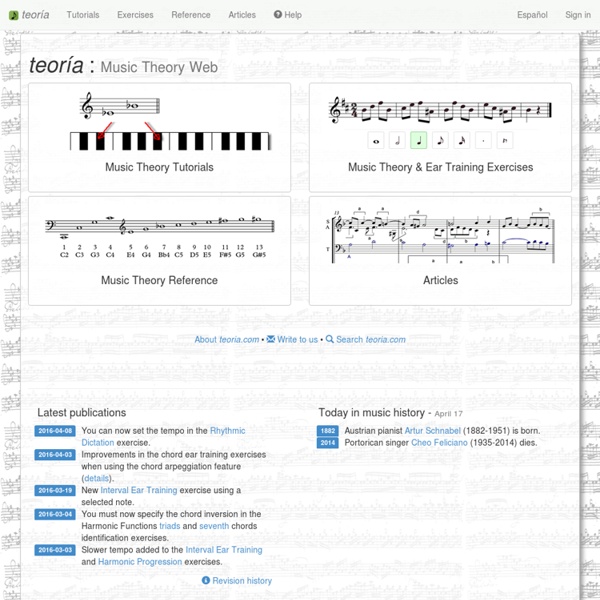Zoom
Trash
Related:



Musical Mind: Single Note Solfege Drill Error: Java version 1.5 or higher is required for the exercises on this site. Click here to download the latest version of Java. You will hear a tonicization followed by a note. Identify the note you hear. You may switch levels or change between solfege/scale degrees using the drop-down menus. tips -- high scores -- comments Greg's Tips Identifying one note at a time is the simplest type of melodic dictation. Play tonic again, and sing a scale. In order to gain speed, however, once you've mastered the system above, it's important to: Identify the scale degree/solfege simply by its 'feel' without directly comparing it to tonic in your mind. Next Steps Start paying attention to the first and last notes of phrases in the music you listen to. High Scores Comments
Piano Lessons » Learn How To Play Piano Today! Free Piano Music! Selon Monique Palomares qui écrit sur mamalisa.com, En cherchant des renseignements sur qui étaient ces "compagnons de la marjolaine", j'ai trouvé que la marjolaine était utilisée dans les chansons comme la rose ou le muguet, comme prélude à l'amour, ainsi que le fait que les jeunes gens qui partaient faire la fête mettaient des brins de marjolaine qui dépassaient de leurs bottes, formant ainsi une mouvante "Compagnie de la Marjolaine", les deux versions disant qu'ils étaient des séducteurs. J'ai aussi trouvé dans "Trésors des plus belles mélodies de tous les temps et de tous les pays", Delfolie, Editions Edsco, Chambéry, 1947" qu'au 15ème siècle, les gens ne disaient pas "donner la sérénade" à quelqu'un mais "réveiller les pots de la marjolaine" et que la Confrérie de la Marjolaine était la confrérie des parfumeurs, très puissante parce que la cour et la ville faisait un usage intense des parfums. La chanson remonte aux alentours de 1650.
flowkey | Learn piano online As a beginner I was able to progress very quickly. It was so easy to get started and learn new songs. I can’t wait for the mobile version! Sabine C., Research associate at a German university I wanted to play 8 out of every 10 songs flowkey had available. For someone as early on in piano as me seeing the highlighted black keys was a huge help and watching the hand positions from that camera angle was perfect. Ron N., 64, from Alaska, USA I’m a French medicine student, and I had to stop piano lessons last year because of my studies. Thibaut G., Student, from France It’s really fun because you’re teaching yourself. Felix M.,14, school student from Berlin, Germany
Ornette Coleman’s “Lonely Woman” is the most hauntingly beautiful song in jazz. Photo by -/AFP/Getty Images Read more of Slate’s remembrances of Ornette Coleman. On May 22, 1959, the Ornette Coleman Quartet stepped into Radio Recorders studio in West Hollywood—where Elvis Presley and Louis Armstrong had recorded some of their hits—and, all in one day, laid down six Ornette originals. They all appeared on an album called The Shape of Jazz to Come, an extraordinary mix of gentle blues, up-tempo frenzy, and a five-minute ballad called “Lonely Woman” that was unlike anything ever heard. Baffling at the time, though even then strangely mesmerizing, it quickly emerged—and still remains—the most hauntingly beautiful song in jazz. The song (which I already wrote about, in some detail, in my book 1959: The Year Everything Changed) begins with Charlie Haden playing a slow bass dirge and Billy Higgins swirling a fast drum riff, an unusual pairing from the get-go. After reciting the theme a couple times, Coleman takes his solo.